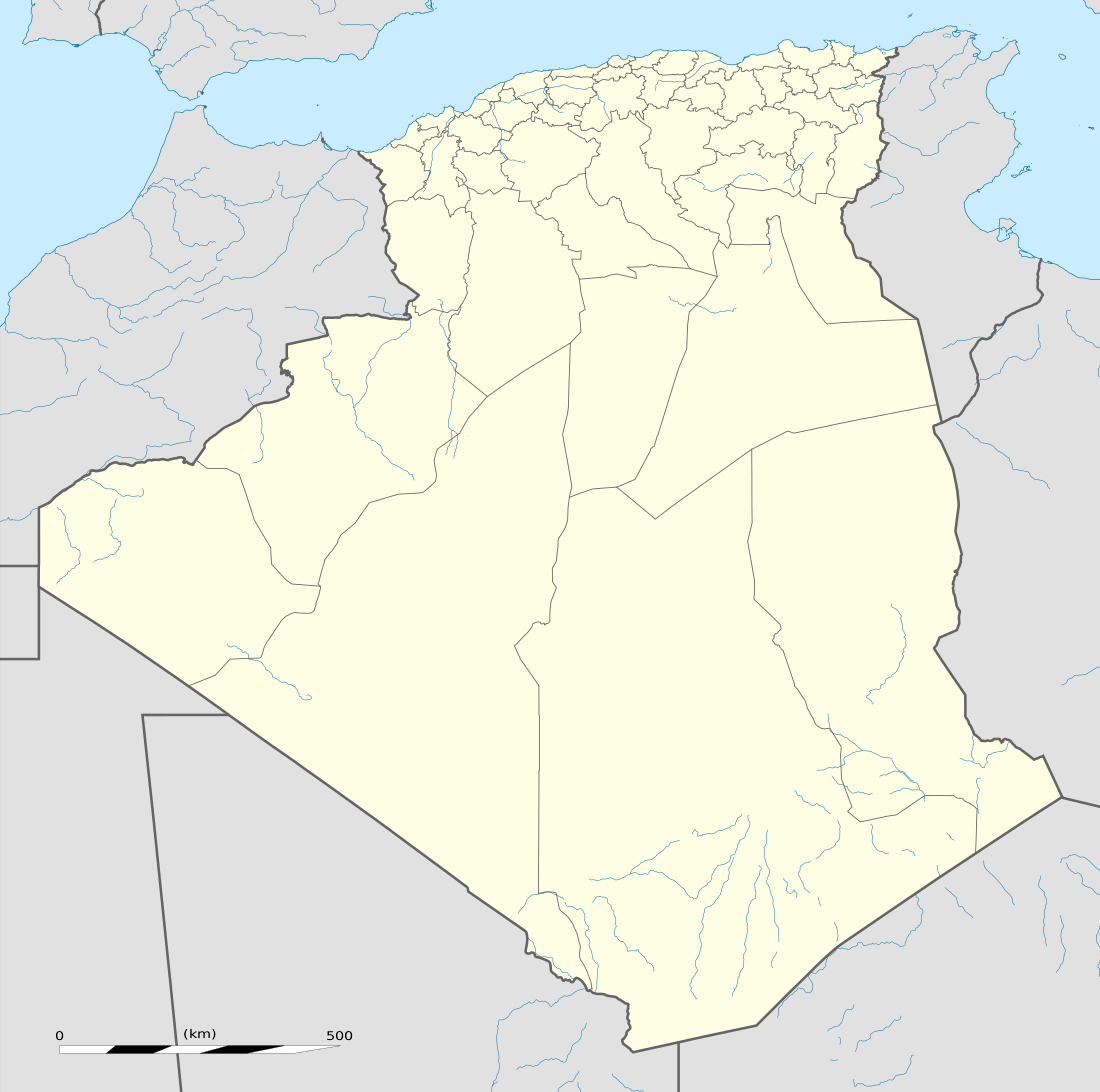Albulae
 Shown within Algeria | |
| Location | Algeria |
|---|---|
| Region | Aïn Témouchent Province |
| Coordinates | 35°18′00″N 1°08′00″W / 35.3°N 1.133333°W |
Albulae is an ancient city and former bishopric in Roman Africa. It remains a titular see of the Roman Catholic Church.[1] It is identified with the modern town of Ain Temouchent, in present Algeria, near the Moroccan border.[2]
Characteristics
Albulae was a Roman settlement in the Roman province of Mauretania Caesariensis, whose site is now occupied by Aïn Témouchent in western Algeria.
Albulae was made of a Roman fort and a vicus (small village-city) populated by romanised Berbers. It was founded by Hadrian in 119 AD with the name "Proesidium Sufative", and renamed one century later as Albulae (or "albine" city in Latin). It was a Christian center after the fourth century (and some Christian Berbers remained living there until the tenth century, according to Arab historian El Békri [3]).
Albulae, according to historian Lawless, was a vicus that achieved independent status from the castrum-fort and had an important pagan temple, later converted to Christian church. The Roman settlement probably reached 5,000 inhabitants and was surrounded by many farms[4]
History
In 119 AD, under the Roman Emperor Hadrian, the procurator Seius Avitus established -near the perhaps Phoenician settlement called Sufat- a military outpost called Praesidium Sufative.[5] By the end of that 2nd century, the vicus that sprang up around the military outpost had grown to become a regular Roman African town, with an economy based on agriculture and commerce, and with a Latin name, Albulae, perhaps in reference to the limestone that was quarried there.[6]

At the beginning of the 3rd century, a new line of defensive forts was constructed further south, reducing further the military character of Albulae, but inscriptions show that it continued to be a base for various military detachments. They also show that the goddess "Caelestis", who had taken the place of the Phoenician Tanit was worshipped there and that a temple to the otherwise unknown goddess "Dea Maura" was rebuilt in 299 AD.
The Antonine Itinerary, which may be of the 3rd century, indicated a station Ad Albulas 30 miles from the station Ad Rubras and 13 miles from the station Ad Dracones (Hamam Bou Hajar).[7]
It appears that the town was never given the rank of "Municipium" and after the Vandal invasion in the fifth century was reduced to a few hundred inhabitants, because no Roman garrison remained there[8]
The 7th-century Arab invasion under Uqba ibn Nafi led to the Islamization of the local Berber population, but the Arab historian El Békri mentioned that there were still some Christian Berbers at the site in the 10th century.[9]
.svg.png)
The latest inscription discovered is an epitaph of 544 AD and a cache of gold coins of the 5th and 6th centuries was discovered on the site. The date of the disappearance of Albulae has not been determined. There is evidence of an earthquake of perhaps the 7th century, and an archaeologist of 1858 found a layer of cinders, suggesting that the town was burnt. In the 10th century the settlement of "Casr Ibn Sinan" arose on the site, which later became Aïn Témouchent[10]
Albulae was a Christian bishopric by the 4th century and its bishop Tacanus was one of the Catholic bishops that the Arian Vandal king Huneric summoned to Carthage in 484 AD and then exiled. No longer a residential diocese, Albulae is today listed by the Catholic Church as a titular See.
The Coat of Arms of actual Albulae -now called Aïn Témouchent- still had a roman helmet until the 1960s.
History
Albulae was initially important enough in the Roman province of Mauretania Caesariensis to become one of the suffragans of the Metropolitan Archbishopric for its capital, Caesarea Mauretaniae. However, its influence gradually waned.
Titular bishopric
The diocese was nominally restored in 1933 as a Latin titular bishopric.
Titular bishops of Albulae, of the lowest (episcopal) rank, with an archiepiscopal exception, have been :[1]
- Percival Caza (1948.08.11 – 1966.09.22), later Bishop of Valleyfield, Quebec
- Titular archbishop Edward Daniel Howard (1966.12.09 – 1983.01.02), as emeritate; previously Titular Bishop of Isauropolis (1923.12.23 – 1926.04.30), Auxiliary Bishop of Davenport (USA) (1923.12.23 – 1926.04.30), Metropolitan Archbishop of Oregon City (1926.04.30 – 1928.09.26),
Metropolitan Archbishop of Portland in Oregon (USA) (1928.09.26 – 1966.12.09)
- Vicente Credo Manuel, Divine Word Missionaries (S.V.D.) (1983.03.17 – 2007.08.18)
- João Carlos Seneme, Stigmatines (C.S.S.) (2007.10.17 – 2013.06.26), later Bishop of Toledo, Parana, Brazil
- Marco Eugênio Galrão Leite de Almeida (2013.09.25 - ... ), Auxiliary Bishop of São Salvador da Bahia (Brazil)
References
- 1 2 Catholic Hierarchy
- ↑ Alan K. Bowman, Peter Garnsey, Dominic Rathbone, eds. (2000). The Cambridge Ancient History, Volume XI. Cambridge University Press. p. 522.
- ↑ History of Albulae/Ain Temouchent (in French)
- ↑ Lawless, R. "Mauretania Caesartiensis: anarcheological and geographical survey" Section: The Roman Civilian Sites. p.122-195
- ↑ The name Sufat is derived from the Berber word for "running water"
- ↑ Louis Abadie, Aïn-Témouchent de ma jeunesse (Serres 2004 ISBN 978-2-90643177-5), p. 11
- ↑ Recherche des antiquités dans le nord de l'Afrique - Paris 1890 - Appendice 2 "Itinéraire d'Antonin" - p.243
- ↑ G. Camps: Albulae (in French)
- ↑ Auguste Audollent. "Albulae", in Dictionnaire d'Histoire et de Géographie ecclésiastiques, vol. I, Paris 1909, coll. 1739-1740
- ↑ Stefano Antonio Morcelli, "Africa christiana", Volume I, Brescia 1816, pp. 73–74
Sources and external links
%2C_Algeria_04966r.jpg)